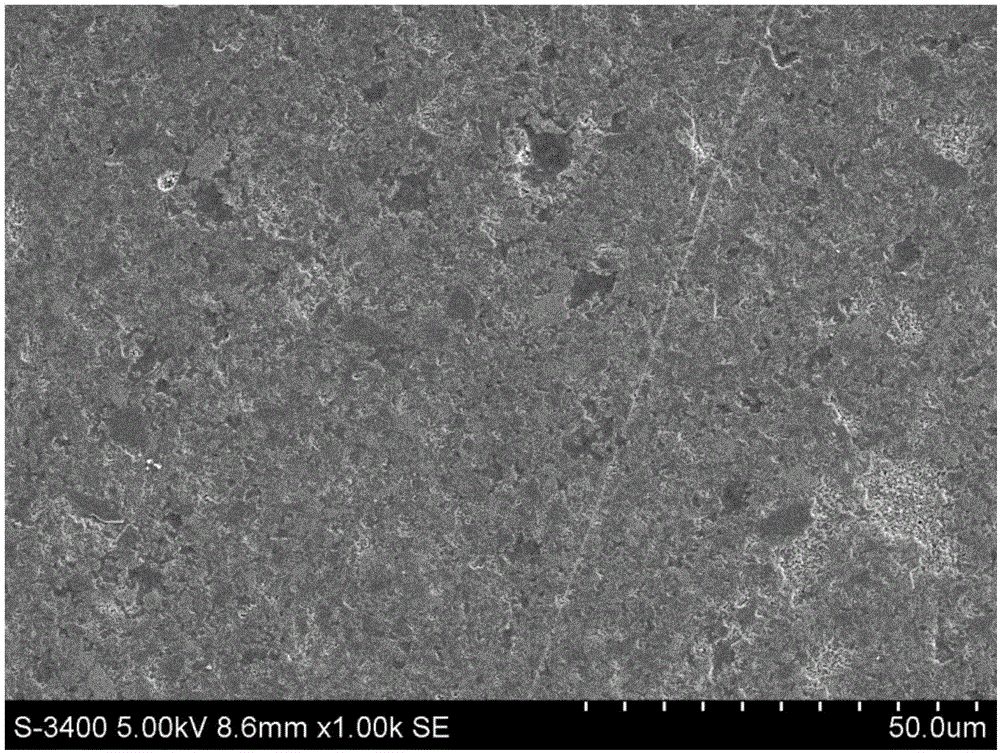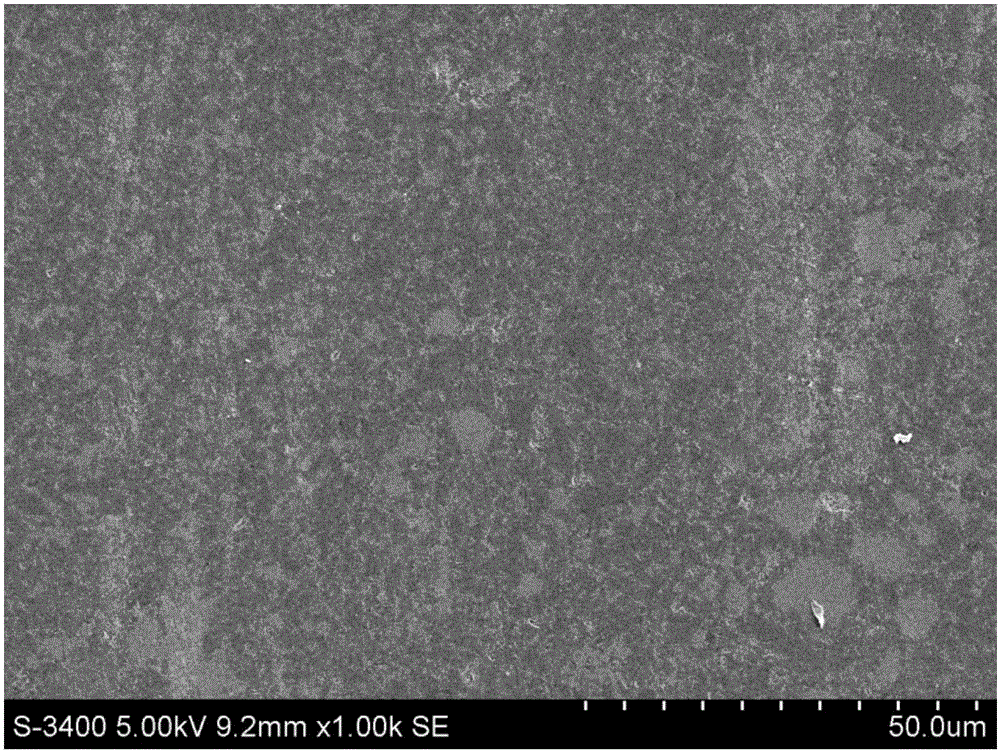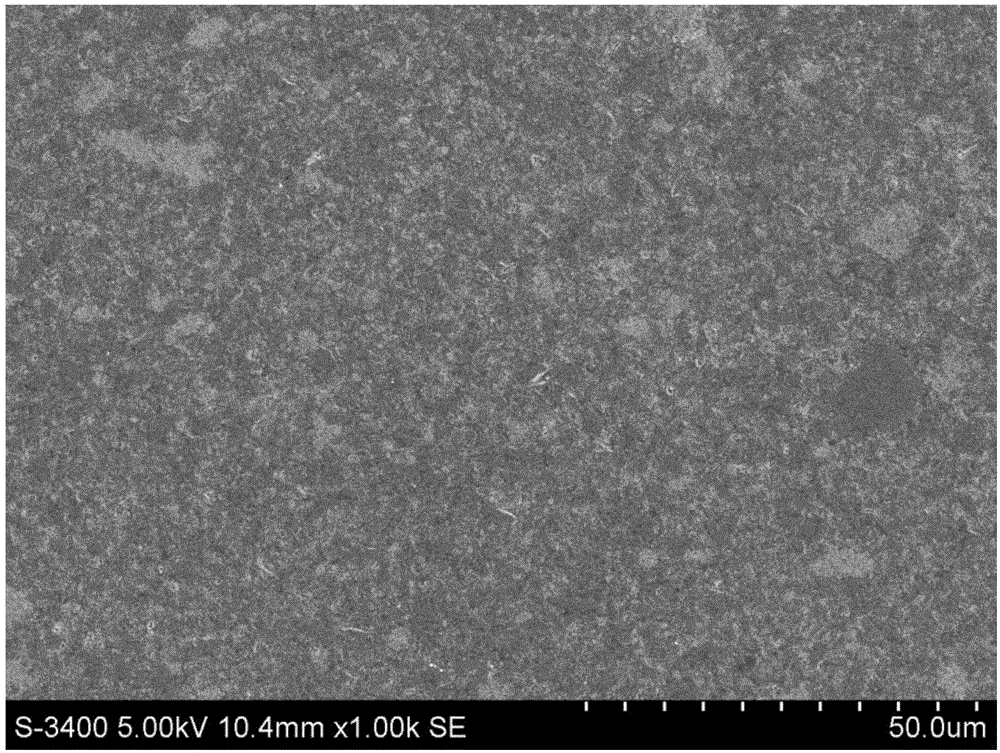Composite ceramic material, and preparation method and application thereof
A technology of composite ceramics and press molding, which is applied in the field of materials, can solve the problems of unreliable process, complicated process, high hardness and melting point, etc., and achieve the effect of corrosion resistance, simple process and high elastic processing
- Summary
- Abstract
- Description
- Claims
- Application Information
AI Technical Summary
Problems solved by technology
Method used
Image
Examples
Embodiment 1
[0066] (1) prepare slurry, D 50 A powder of about 2 microns is added in proportion to zirconia: silicon dioxide: aluminum oxide: boric acid: calcium oxide: zinc oxide: titanium dioxide = 50:25:15:4:2:2:2 into ethanol, Add 0.2wt% polyvinyl butyral as a binder, and mix according to ball milling to obtain a uniformly mixed slurry;
[0067] (2) Pour the mixed slurry into a tray, dry at 120°C, and then pass the dried raw material through a 60-mesh sieve to obtain a mixed powder;
[0068] (3) The mixed powder is compacted under a pressure of 12MPa, and then subjected to cold isostatic pressing under a pressure of 280MPa;
[0069] (4) The ceramic green body was placed in a muffle furnace, sintered at 1050° C., and kept for 3 hours. At this time, the bending strength of the ceramic green body was measured to be 38.6 MPa, and the porosity was 38.2%.
[0070] (5) Place the ceramic green body in a 5% silane coupling agent (γ-methacryloxypropyltrimethoxysilane) solution, soak for 3 hour...
Embodiment 2
[0077] (1) prepare slurry, D 50 A powder of about 50 microns is added to ethanol at a ratio of zirconia: silicon dioxide = 1:1, and 0.2wt% polyvinyl butyral is added as a binder, and mixed according to the method of ball milling to obtain a mixed Uniform slurry;
[0078] (2) Pour the mixed slurry into a tray, dry at 120°C, and then pass the dried raw material through a 60-mesh sieve to obtain a mixed powder;
[0079] (3) The mixed powder is compacted under a pressure of 12MPa, and then subjected to cold isostatic pressing under a pressure of 280MPa;
[0080] (4) The ceramic green body was placed in a muffle furnace, sintered at 1200° C., and kept for 2 hours. At this time, the bending strength of the ceramic green body was measured to be 37 MPa, and the porosity was 41.2%.
[0081] (5) Place the ceramic green body in a 5% silane coupling agent (vinyl tri-tert-butyl peroxysilane) solution, soak it for 3 hours, then take it out and dry it in the air, and dry it at 120°C for 30...
Embodiment 3
[0086] (1) prepare slurry, D 50 A powder of about 20 microns is added to ethanol at a ratio of zirconia:silicon dioxide = 1:1, and 0.2wt% polyvinyl butyral is added as a binder, and mixed by ball milling to obtain a mixed Uniform slurry;
[0087] (2) Pour the mixed slurry into a tray, dry at 120°C, and then pass the dried raw material through a 60-mesh sieve to obtain a mixed powder;
[0088] (3) The mixed powder is compacted under a pressure of 12MPa, and then subjected to cold isostatic pressing under a pressure of 280MPa;
[0089] (4) The ceramic green body was placed in a muffle furnace, sintered at 600° C., and kept for 2 hours. At this time, the bending strength of the ceramic green body was measured to be 30 MPa, and the porosity was 45%.
[0090] (5) Place the ceramic body in a 5% silane coupling agent (γ-glycidoxytrimethylsilane) solution, soak it for 2 hours, then take it out and dry it in the air, and dry it at 120°C for 30 minutes to obtain the surface treatment ...
PUM
| Property | Measurement | Unit |
|---|---|---|
| particle diameter | aaaaa | aaaaa |
| flexural strength | aaaaa | aaaaa |
| flexural strength | aaaaa | aaaaa |
Abstract
Description
Claims
Application Information
 Login to View More
Login to View More - R&D
- Intellectual Property
- Life Sciences
- Materials
- Tech Scout
- Unparalleled Data Quality
- Higher Quality Content
- 60% Fewer Hallucinations
Browse by: Latest US Patents, China's latest patents, Technical Efficacy Thesaurus, Application Domain, Technology Topic, Popular Technical Reports.
© 2025 PatSnap. All rights reserved.Legal|Privacy policy|Modern Slavery Act Transparency Statement|Sitemap|About US| Contact US: help@patsnap.com



